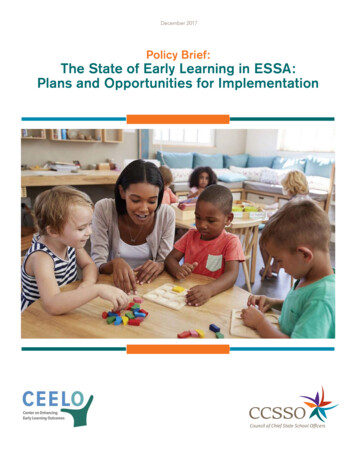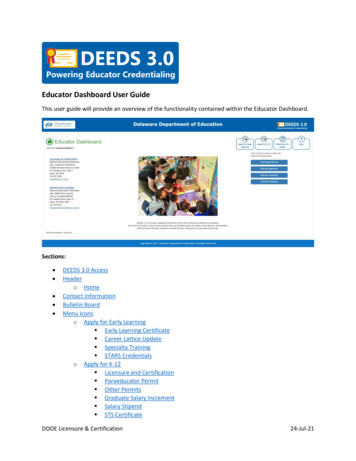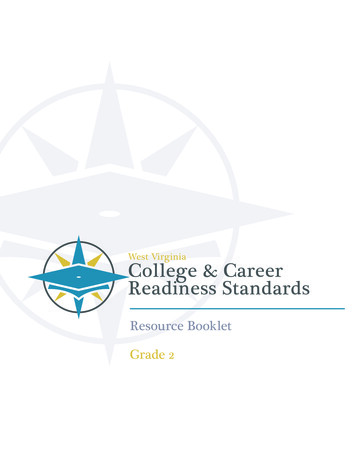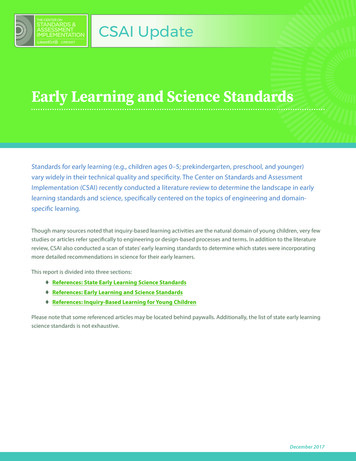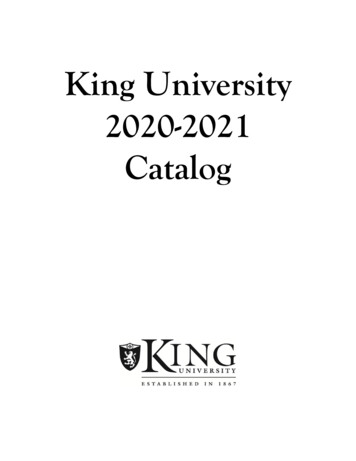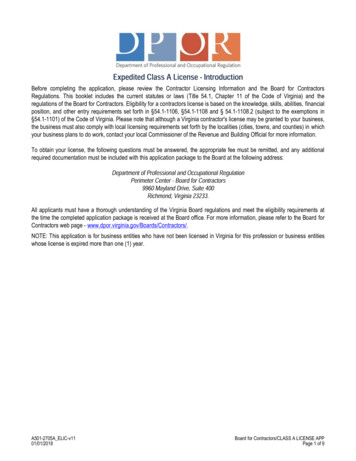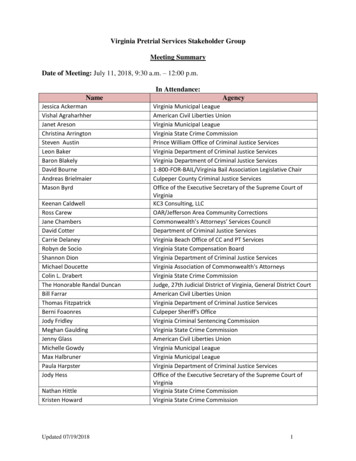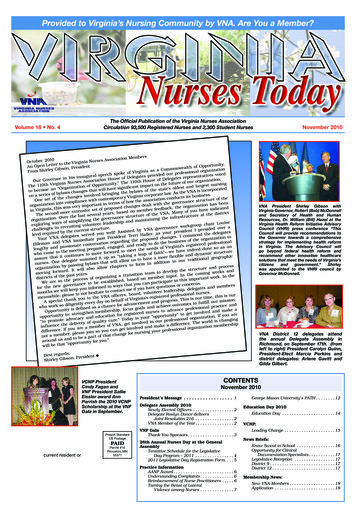
Transcription
VIRGINIA’S EARLY LEARNING & DEVELOPMENT STANDARDS(ELDS)BIRTH-FIVE LEARNING GUIDELINESVIRGINIA BOARD OF EDUCATION1VIRGINIA BOARD OF EDUCATION doe.virginia.gov
CONTENTSSED1.3. Becoming autonomous and independentACKNOWLEDGEMENTS4INTRODUCTION6THE VALUE AND NEED FOR A UNIFIED SET OF EARLY LEARNING ANDDEVELOPMENT STANDARDS IN VIRGINIA6GROUNDING KNOWLEDGE AND GUIDING PRINCIPLES6GROUNDING KNOWLEDGE6GUIDING PRINCIPLES7ABOUT CULTURALLY RESPONSIVE PRACTICECulturally Responsive Caregivers and EducatorsHOW TO USE VIRGINIA’S UNIFIED EARLY LEARNING ANDDEVELOPMENT STANDARDS889DESIGN OF THE VIRGINIA EARLY LEARNING AND DEVELOPMENTSTANDARDS DOCUMENT9VIRGINIA’S EARLY LEARNING AND DEVELOPMENTSTANDARDS AT A GLANCE10ORGANIZATION OF THE STANDARDS12PROCESS13WRITING STYLE13AREA ONE: APPROACHES TO PLAY AND LEARNING (APL)APL1. CURIOSITY AND INITIATIVEAPL1.1. Being curious learnersAPL1.2. Taking initiative14151616APL2. CREATIVITY AND IMAGINATIONAPL2.1. Showing creativity and imagination1717APL3. EXECUTIVE FUNCTIONS AND COGNITIVESELF-REGULATIONAPL3.1. Focusing and paying attentionAPL3.2. Building working memoryAPL3.3. Thinking flexibly and adaptingAPL3.4. Inhibiting responsesAPL3.5. Persisting and problem-solving181819202122APL4. BEHAVIORAL SELF-REGULATIONAPL4.1. Managing actions and behaviors2323AREA TWO: SOCIAL AND EMOTIONAL DEVELOPMENT (SED)SED1. POSITIVE SELF-CONCEPTSED1.1. Developing self-awarenessSED1.2. Developing self-confidenceSED2. EMOTIONAL COMPETENCESED2.1. Seeing and naming emotions in self and othersSED2.2. Expressing emotionsSED2.3. Communicating feelings, wants, and needsSED2.4. Regulating emotionsSED2.5. Showing care and concern for others282829303132SED3. INTERACTING WITH OTHERSSED3.1. Developing relationships with adultsSED3.2. Developing relationships with other childrenSED3.3. Engaging in cooperative playSED3.4. Solving social interaction problems3333343536AREA THREE: COMMUNICATION, LANGUAGE ANDLITERACY DEVELOPMENT (CLLD)CLLD1. COMMUNICATIONCLLD1.1. Understanding verbal and nonverbal cuesCLLD1.2. Using vocabulary and nonverbal cues to communicateCLLD1.3. Learning and engaging in conversational interactionsCLLD2. FOUNDATIONS OF READINGCLLD2.1. Paying attention to print as meaningfulCLLD2.2. Understanding ideas, vocabulary, andinformation in stories and textsCLLD2.3. Learning spoken language is composed ofsmaller segments of soundCLLD2.4. Learning how letters and print workto create words and meaningCLLD3. FOUNDATIONS OF WRITINGCLLD3.1. Drawing, scribbling, and writing to communicateCLLD3.2. Developing writing habits and skillsCLLD3.3. Handling writing toolsAREA FOUR: HEALTH AND PHYSICAL DEVELOPMENT (HPD)HPD1. USING SENSESHPD1.1. Learning through all 9HPD2. GROSS MOTORHPD2.1. Developing large muscle controlHPD2.2. Exploring the environment505051HPD3. FINE MOTORHPD3.1. Using eyes and hands togetherHPD3.2. Developing small muscle control525253VIRGINIA BOARD OF EDUCATION doe.virginia.gov
HPD4. PHYSICAL HEALTH AND SELF-CAREHPD4.1. Taking care of daily health needsHPD4.2. Adopting safe behaviorsHPD4.3. Eating with healthy habitsHPD4.4. Developing healthy habits for rest and sleepAREA FIVE: COGNITIVE DEVELOPMENT (CD)CD1. SCIENCE: THE NATURAL AND PHYSICAL WORLDCD1.1. Paying attention to the natural worldCD1.2. Testing questions and ideas545455565758595960CD2. Social Science: People, Community, and CultureCD2.1. Learning about ways that people interactCD2.2. Understanding relationships and connectionsCD2.3. Learning about differences61616263CD3. MATHEMATICSCD3.1. Comparing numbers, counting, and recognizing quantitiesCD3.2. Understanding number relationships andsolving problems using operationsCD3.3. Geometric thinking and spatial reasoningCD3.4. Sorting, classifying, and patterningCD3.5. Describing, comparing, and measuring6464CD4. FINE ARTSCD4.1. Exploring and expressing ideas through movement and danceCD4.2. Learning about and through musicCD4.3. Building understanding, empathy, andrelationship skills through drama and theatre artsCD4.4. Using visual arts media to express thoughts and feelings656667686969707172GLOSSARY73APPENDIX A: REFERENCES AND SOURCES CONSULTED77APPENDIX B: STATES CONSULTED823VIRGINIA BOARD OF EDUCATION doe.virginia.gov
ACKNOWLEDGEMENTSPROJECT LEADERSHIPLEAD DEVELOPMENT TEAMYAOYING XUVirginia Commonwealth University(Co- Principal Investigator)JOAN RHODESVirginia Commonwealth University(Co-Principal Investigator)DEANA BUCKPartnership for People Disabilities VirginiaCommonwealth UniversityIRENE CARNEYProject ManagerMICHAEL BOLLINGEarly, Elementary and Reading Education,James Madison UniversityCHRISTINE HARRISDirector, Office of HumanitiesYoung Children’s Program, JamesMadison UniversityLEAH WALKERTAMILAH RICHARDSONAssociate DirectorOffice of Early ChildhoodCHERYL STROBELAssociate Director of Early Childhood,RetiredANN PARTEEHOLLY MCCARTNEYEarly, Elementary and Reading Education,James Madison UniversityMARK ALLANEarly Childhood Special EducationCoordinatorERIN CARROLLPAT KENNEDYDirector, Office of Equity andCommunity EngagementVIRGINIA DEPARTMENTOF EDUCATIONDirector Office of Early Childhood*TERESA HARRISSAMANTHA HOLLINSAssistant Superintendent, Department ofSpecial Education and Student ServicesTERESA HARRISJames Madison UniversityJENNA CONWAYAPPROACHES TO PLAY ANDLEARNINGAssistant Superintendent, Department ofLearning InnovationAssociate Director Pre-K ProgramsChief School Readiness Officer,Division of School ReadinessEARLY LEARNING ANDDEVELOPMENT STANDARDSWORK GROUPS (*CHAIR)INTERAGENCY (VDOE)REVIEWERSMARYAM SHARIFIANEarly, Elementary and Reading Education,James Madison UniversityDAWN HENDRICKSSOCIAL AND EMOTIONALDEVELOPMENTJESSICA COSTA*SANDY WILBERGERSpecialist for English Learner InstructionVDOE Training and TechnicalAssistance Center (T/TAC), VirginiaCommonwealth UniversityDEBRA DELOZIERMathematics SpecialistBONNIE GRIFACARMEN KUREKElementary English/Reading SpecialistPartnership for People with Disabilities,Virginia Commonwealth UniversityBRANDI MCCRACKENSARA MILLERElementary History and Social ScienceSpecialistEducation and Special Education,Longwood UniversityANNE PETERSONScience CoordinatorCOMMUNICATION,LANGUAGE ANDLITERACY DEVELOPMENT*CHRISTINE SCHULLEarly Childhood Development,Northern Virginia Community CollegeCHRISTAN COOGLEEarly Childhood Special Education,George Mason UniversityLESLIE LACROIXCollege of Education and HumanDevelopment,George Mason UniversityMIRA WILLIAMSEducation Foundations andExceptionalities,James Madison UniversityPhysical Development and Health*DEANA BUCKPartnership for People with Disabilities,Virginia Commonwealth UniversityTERESA HARRISEarly, Elementary and Reading Education,James Madison UniversityBELINDA HOOPERDepartment of Child Care, John TylerCommunity CollegeJESSICA LEEOccupational Therapy, VirginiaCommonwealth UniversityCHRISTINE SPENCECounseling and Special Education,Virginia Commonwealth UniversitySociety for Research in ChildDevelopment (SRCD) Pre-Doctoral StatePolicy Fellow, Office of Early Childhood4VIRGINIA BOARD OF EDUCATION doe.virginia.gov
COGNITIVE DEVELOPMENT*MEG PIENKOWSKISmart Beginnings of Greater RichmondIRENE CARNEYELDS Project ManagerKIM GREGORYEarly Childhood Development,Virginia Western Community CollegeKATHY LARUEEarly Childhood Education,J Sargeant Reynolds Community CollegeMISTI MUELLERTeaching and Learning, VirginiaCommonwealth UniversityPROJECT PARTICIPANTSEARLY LEARNING ANDDEVELOPMENT STANDARDSSTAKEHOLDERSMARITSA ALGERNorfolk Public Schools (Retired),Norfolk, VAADRIA BADERLeafSpring Schools, Richmond, VACHANEL BEAPeter Paul Development Center,Richmond, VAEL’TANYA BROWNKinderJam Founder, George MasonUniversity PhD CandidateCAROL CLARKESmart Beginnings, Fredericksburg, VAJESSICA COSTAVirginia Department of EducationROSALIND CUTCHINSThe Children’s Center, Suffolk, VATAMMY MANNThe Campagna Center, Alexandria, VAANITA MCGINTYYESENIA DELACRUZUniversity of Virginia (PALS)Total Action for Progress, Roanoke, VACHERYL MORMONJENNIFER EDELENVirginia Alliance of Family Child CareAssociations, Richmond, VAWolf Trap Foundation for thePerforming Arts, Vienna, VABERGEN NELSONNAVINE FORTUNEVirginia Commonwealth UniversityHealth System, Richmond, VANorfolk State UniversitySHIKEE FRANKLINLELIA TYNESRetired Birth-3 Coordinator, NorfolkPublic Schools, Norfolk, VAAMANDA WILLIFORDUniversity of Virginia (VKRP)JESSICA WHITTAKERUniversity of Virginia (VKRP)KYRA WOOLEYNorfolk Public Schools, Norfolk, VAMYRA SAWYERSHampton Roads Community ActionProgram, Inc., Newport News, VAVirginia Child Care Association, GlenAllen, VABONNIE GRAHAMCHRISTINE SCHULLNew River Community College, Dublin,VANorthern Virginia Community College,Alexandria, VAPHILLIP HAWKINSKIM SOPKONorfolk Public Schools, Norfolk, VAGeorge Mason UniversityDAWN HENDRICKSKATIE SQUIBBVirginia Department of EducationVirginia Early Childhood Foundation,Richmond, VACORI HILLPartnership for People with Disabilities,Virginia Commonwealth UniversityBWEIKIA STEENGeorge Mason UniversityDOROTHY HUGEEAMY STUTTResource Early Childhood SpecialEducation Teacher,Fairfax County SchoolsChild Development Resources, Norge,VACECILIA SUAREZGAIL JOHNSONCreative Learning School, Alexandria, VALeafSpring Schools, Richmond, VALISA TERRYARLENE KASPEREarly Intervention ProfessionalDevelopment Consultant, VirginiaCommonwealth University, VirginiaEarly Intervention ProfessionalDevelopment CenterVirginia Department of EducationWENDY LIPSCOMBBlessed Sacrament Huguenot HighSchool, Powhatan, VA5VIRGINIA BOARD OF EDUCATION doe.virginia.gov
INTRODUCTIONThe first five years of a child’s life involve significant impact on the developing brain and early learning. The concepts and skills that children learn during their early yearsalso lay the groundwork for a successful transition to kindergarten and all later schooling. Virginia is committed to providing every child in the Commonwealth with theexperiences and supports that will provide a solid foundation for their learning and life.THE VALUE AND NEED FOR A UNIFIED SET OF EARLY LEARNING AND DEVELOPMENT STANDARDS INVIRGINIAVirginia is home to over 500,000 children ages birth through five. Many of the Commonwealth’s young children have access to early settings and experiences that are wellequipped to support development and learning. Others, however, lack that access for a number of reasons including geography; cost; demand that exceeds supply; andinadequate resources or supports for quality care. Still other children have needs that require special considerations from their programs and providers.The goal of early care and education is to help all children prepare for kindergarten, and for a good start in life, through high quality early education or early interventionprograms. Virginia elevates both care and education as important aspects of what educators attend to in their work with young children, regardless of the setting inwhich the work takes place. Many factors contribute to program quality, including the provider’s understanding of how children learn and grow throughout earlychildhood, and what adults can do to best support the developing child. Virginia defines an early childhood provider as any adult responsible for the early care andeducation of young children, including parents/families, caregivers, educators, and program leaders as primary examples. Provider groups should not be viewed as mutuallyexclusive: caregivers include parents/families and teachers, and teachers should be viewed as caregivers inclusive of parents/families. Virginia’s Unified Early Learning andDevelopment Standards (ELDS) provide all early childhood providers (i.e., parents/families, caregivers, educators, and program leaders) with a resource for understandingwhat children should know and be able to do as they grow and change from birth until they enter kindergarten.GROUNDING KNOWLEDGE AND GUIDING PRINCIPLESAt the core of the ELDS is the belief that all children in Virginia deserve to build on their capabilities, and deserve to start school ready to learn. Related to that convictionis the belief that early childhood caregivers and educators need access to clear, actionable guidance that supports their understanding of how children develop and theassociated skills that emerge as they actively engage with their environment.These ELDS intentionally start with development at birth. What infants and toddlers come to know and do is inextricably linked to the ways in which adults are able totune into the child’s curiosity and interest in their environment. When adults give words to feelings, name what they are seeing, ask questions and so forth, they are everexpanding what infants and toddlers come to know about themselves and their world.In order to highlight discrete skills and behaviors that adults should look for when interacting with and observing a young child, this document focuses on each of fiveAreas ofDevelopment. Within each area, the ELDS describe specific concepts and skills that adults should look for and support as children grow and change. All areas are groundedin what is known about early development and learning, and beliefs about young children and early childhood education.GROUNDING KNOWLEDGEWe know that during the years from birth through age 5, and particularly the years from birth through 3, the young child’s brain is growing and developing thecapacity for all later learning (Shonkoff & Phillips, 2000). We also know that the brain’s growth is supported or undermined as a function of the child’s environment andexperiences. Finally, and most importantly, we know that interactions and relationships with caregiving adults and teachers are of primary importance in supporting achild’s early development and learning (Child Trends, 2015; Dougherty, 2014; Flores et al., 2016).What happens - or what does not happen - during a child’s first five years makes an important difference that will influence the child’s life and learning well beyond theearly childhood period.6VIRGINIA BOARD OF EDUCATION doe.virginia.gov
GUIDING PRINCIPLESOver the course of a child’s early years, we begin to know them by paying careful attention to the unique individual they are becoming. Supporting learning for allchildren means understanding how we generally expect a child to develop and change. Supporting learning for an individual child means paying careful attention towhether and how the child progresses; considering whether something is interfering with the child’s development; and learning ways to help a child whose growth is notunfolding as we typically expect. While children bring their individuality and diversity to early childhood settings, these guiding principles reflect knowledge that willhelp adults provide the best environments, experiences, and relationships for all the children in their care. An available, responsive adult is the most important support to the young child’s learning. Children are born wired to learn, but learning doesnot occur in a vacuum. Adults activate, motivate, guide, interpret, and support the young child’s exploration and understanding of their world. Parentsare children’s first and most important teachers. When children enter a program, or another adult’s care, their caregivers and educators partner withparents in making the most of the early years as the foundation for lifelong learning Development occurs with some predictability, but children progress through their development at their own rate and in their own way.We can describe how development generally unfolds - which skills are likely to come before others and when. But a child may skip over some stepsaltogether. They may progress in one area more quickly or slowly than others. Developmental guidelines provide a road map, but each child will havetheir own, unique route for learning. Learning is a dynamic phenomenon, integrated across all areas of development. As young children grow and learn, their changing abilitiesreflect the interplay of many areas of development, working in concert with one another. Preschoolers’ ability to manage their impulses, for example,enables them to persist through the challenge of building with blocks as they develop as mathematical thinkers; to quiet themselves in order to listen toothers as they grow in social skill and in collaboration; and to follow established rules of play as they become members of a group that learns and playstogether. Skills may be thought about in terms of a particular area of development, but they are very often interwoven and interdependent. Early learning will require special attention, support, and strategies for children with developmental disabilities or delays. Early growth anddevelopment for some children will be influenced by the presence of an individual difference, a disability, or a developmental delay. These differencescan include visual or hearing impairments; communication, speech or language delays; physical disabilities or motor delays; and differences affectinga child’s social development or emotional growth. Children with disabilities may need adaptive materials and environments to support their learningand may benefit from numerous opportunities for participation and interaction. The presence of such differences should not prevent a child fromparticipating in an early childhood program with peers whose development is more typical. That said, caregivers and educators may need access tomore specialized guidance, equipment, materials and methods to help these young learners to develop and demonstrate their abilities. Those additionalteaching tools and strategies are often helpful, not only for a child or children with special needs, but for other children as well. A child’s home culture and language must be recognized, respected, and accommodated in the early learning processes. The ELDS describehow we generally expect children to change and learn over time. The ELDS include indicators that refer to behaviors such as curiosity, persistence,attention, and exploration. As caregivers and educators use these standards to understand learning and development in general, it is important to alsorecognize that children bring their cultural learning to the process. That learning might have taught a child, for instance, to focus on and follow thedirectives of adults, as opposed to taking initiative on their own. A young child might also have learned to inhibit their questions and comments, outof deference to adults, and to quietly wait and observe until invited to speak. Understanding a child in the context of their culture calls on us to partnerwith families who can help us learn about their culture’s practices and strengths. Language is only one aspect of culture, but language requires its ownconsiderations. Children who are multilingual learners, for example, need ongoing connection to, and learning in, their home language as they learnEnglish as their second or subsequent language. Both multilingual learners and English learners will also benefit from caregivers and educators whogive careful thought and planning to how concepts and skills will be introduced. Other factors in the child’s environment will have an impact on learning. Experiences that can cause challenges to a child’s learning includeillness, poverty, and trauma. It is important that caregivers and educators know and understand each child fully in order to provide the best and mosteffective care and teaching. It is also important that caregivers and educators are able to access the knowledge and develop the practices that will supportchildren whose circumstances present such challenges.7VIRGINIA BOARD OF EDUCATION doe.virginia.gov
Young children learn through play. Play, alone or with other children, is the child’s laboratory. Playing provides children with opportunities toimagine, question, investigate, collaborate, negotiate, practice, and discover. Playing is how young children learn. Caregivers and educators observeand guide children in play to ensure that children continue to expand their learning as they play. Technology and digital experience can have a place in early learning, but should not be the primary medium for learning. Children aged 2and under should have little or no reliance on digital devices for their entertainment or learning. It is undeniably the case, however, that most youngchildren see and interact with the digital world - even if only through a parent’s cell phone - from a very young age. The imperative for adults who aresupporting young children’s experience of digital technology, is to position those media and devices as tools that enable investigation, communication,collaboration, and creativity.ABOUT CULTURALLY RESPONSIVE PRACTICEEstablishing expectations for culturally responsive practice among Virginia’s early childhood workforce is critical to supporting the effective delivery of care andinstruction to Virginia's diverse early learner population. Culture strongly influences the attitudes, values, and behaviors that young children, caregivers and educatorsbring to the caregiving and instructional processes, making culturally responsive caregivers and educators necessary for the equitable achievement of today’s increasinglydiverse population of children in early childhood learning spaces. Culturally responsive caregivers and educators see the diversity in their classrooms or learning spaces asan asset and use their knowledge on children’s backgrounds to enrich care and education experiences. Caregivers and educators form a thorough understanding of thespecific cultures of the children they care for and teach, how that culture affects children’s learning behaviors, and how they can change interactions and instruction toembrace the differences.Culturally Responsive Caregivers and Educators: See cultural differences as assets; Validate the inequities impacting children’s lives; Cultivate relationships beyond the classroom or learning space, anchored in affirmation, mutual respect, and validation; Believe that ALL children can succeed and communicate high expectations for all children; Engage in reflection of their beliefs, behaviors, and practices; Utilize children’s cultures as vehicles for learning; Challenge racial and cultural stereotypes, prejudices, racism, and other forms of intolerance, injustice, and oppression; Mediate power imbalances in classrooms and learning spaces based on race, culture, ethnicity, and class; Communicate in linguistically and culturally responsive ways; and Collaborate with families and the local communityAchieving education equity- that is eliminating the predictability of student outcomes based on race, gender, zip code, ability, socioeconomic status or languages spokenat home- indeed requires that caregivers and educators engage in culturally responsive practice. It also requires that caregivers and educators are culturally competent, exhibitcultural proficiency and are fully cognizant of what culturally relevant pedagogy and culturally relevant/responsive teaching entails (see glossary for specific definitions that havebeen adopted by the Virginia Department of Education). To learn more about the Virginia Department of Education’s (VDOE) equity commitments (#EdEquityVA)visit the Virginia is For Learners website. There you will find information about Future-Ready Learning, how the VDOE is supporting early learning, and learn about#EdEquityVA initiatives.8VIRGINIA BOARD OF EDUCATION doe.virginia.gov
HOW TO USE VIRGINIA’S UNIFIED EARLY LEARNING AND DEVELOPMENT STANDARDSThis document is designed for adults who care for and teach young children in a variety of settings including home-based child care, center-based child care, Head Startclassrooms, early intervention programs, private preschools, public early childhood programs, and Virginia Preschool Initiative (VPI) classes. Throughout this documentwe refer to these adults as caregivers and educators, and in some cases will use the broader terminology of early childhood providers or simply providers.The ELDS are a reference to help caregivers and educators understand what most children are able to know and to do, across different areas of development, by a givenage. This document describes development across six overlapping age bands. The overlap conveys the reality that children develop at different rates. Individual skills willappear, across children, at different times. Those differences are often consistent with “expected” or “typical” development.This document is not intended to serve as a developmental checklist, an assessment, or a curriculum. Not all children will demonstrate every skill in the same time frameor in the same way. Indicators reflected in each focus area are examples, and not meant to be exhaustive of what we see in all children. It is critical that caregivers andeducators understand that utilizing valid and reliable screening and assessment tools is essential when concerns about a child’s development surfaces. When developmentaldelays are identified early, specialized services can make a tremendous difference in getting development back on track.The ELDS can be used by individual caregivers and educators and early childhood programs to: understand how children build skills and understanding, indifferent areas of development, from birth to age 5; discern whether a particular child is learning and growing according to general expectations; identify topics fortraining to help all providers continually grow and improve as early childhood providers.The ELDS are, in short, the “bottom line” of what we should aim for each child in Virginia. A child whose development and learning generally aligns with these behaviorsand skills will have a good start on their readiness for school and their continued growth throughout life.DESIGN OF THE VIRGINIA EARLY LEARNING AND DEVELOPMENT STANDARDS DOCUMENTThese standards organize information into five Areas of Development. While not reflective of the true, integrated nature of development, this organization aims to helpproviders know what to encourage and what to look for as they support and keep watch over a child’s development and learning. The Areas of Development include: Approaches to Play and Learning Social and Emotional Development Communication, Language and Literacy Development Health and Physical Development Cognitive DevelopmentEach Area of Development is organized into Sub Areas and Focus Areas. Each Focus Area, in turn, details Indicators that describe a developmental progression of how weexpect a child to change across six overlapping age-bands, from birth to age 5. When Focus Areas include skills that develop during the later years, the developmentalprogression will start at the appropriate age range leaving earlier columns blank. This organization aims to underscore the reality that, while development occurs alonga general, expected trajectory, an individual child will not necessarily conform to an exact timeline for achieving milestones. Each child will also, by virtue of individual,environmental, and cultural differences, demonstrate a milestone in varied ways. The ELDS aim to convey some of that variability in both the design of the document andthe substance of the examples provided.The charts on the following pages (VIRGINIA’S EARLY LEARNING AND DEVELOPMENT STANDARDS AT A GLANCE) provide the Sub Areas(e.g., APL1) and Focus Areas (e.g., APL1.1) for each of the five Areas of Development. Each indicator is numbered according to Sub Area and Focus Area, and an alphabetletter is added so that each one is distinct.9VIRGINIA BOARD OF EDUCATION doe.virginia.gov
VIRGINIA’S EARLY LEARNING AND DEVELOPMENT STANDARDS AT A GLANCEApproaches to Play and LearningAPL1. Curiosity and InitiativeAPL1.1. Being curious learnersAPL1.2. Taking initiativeAPL2. Creativity and ImaginationAPL2.1. Showing creativity andimaginationAPL3.Executive Functions andCognitive Self-RegulationAPL3.1. Focusing and paying attentionAPL3.2. Building working memoryAPL3.3. Thinking flexibly and adaptingAPL3.4. Inhibiting responsesAPL3.5. Persisting and problem-solvingAPL4. Behavioral Self-RegulationAPL4.1. Managing actions and behaviorsSocial and Emotional DevelopmentSED1. Positive Self-ConceptSED1.1. Developing self-awarenessSED1.2. Developing self-confidenceSED1.3. Becoming autonomous andindependentSED2. Emotional CompetenceSED2.1. Seeing and naming emotions in self andothersSED2.2. Expressing emotionsSED2.3. Communicating feelings, wants, and needsSED2.4. Regulating emotionsSED2.5. Showing care and concern for othersSED3. Interacting with OthersSED3.1. Developing relationships with adultsSED3.2. Developing relationships with other childrenSED3.3. Engaging in cooperative playSED3.4. Solving social interaction problems10Communication, Language and LiteracyDevelopmentCLLD1. CommunicationCLLD1.1. Understanding verbal andnonverbal cuesCLLD1.2. Using vocabulary and nonverbalcues to communicateCLLD1.3. Learning and engaging inconversational interactionsCLLD2. Foundations of ReadingCLLD2.1. Paying attention to print as meaningfulCLLD2.2. Understanding ideas, vocabulary, andinformation in stories and textsCLLD2.3. Learning spoken language is composed ofsmaller segments of soundCLLD2.4. Learning how letters and print work tocreate words and meaningCLLD3. Foundations of WritingCLLD3.1. Drawing, scribbling, and writing tocommunicateCLLD3.2. Developing writing habits and skillsCLLD3.3. Handling writing toolsVIRGINIA BOARD OF EDUCATION doe.virginia.gov
Health and Physical DevelopmentHPD1. Using SensesHPD1.1. Learning through all sensesHPD2. Gross MotorHPD2.1. Developing large muscle controlHPD2.2. Exploring the environmentHPD3. Fine MotorHPD3.1. Using eyes and hands togetherHPD3.2. Developing small muscle controlHPD4. Physical Health and Self-careHPD4.1. Taking care of daily health needsHPD4.2. Adopting safe behaviorsHPD4.3. Eating with healthy habitsHPD4.4. Developing h
2 virginia board of education doe.virginia.gov contents acknowledgements 4 introduction 6 the value and need for a unified set of early learning and development standards in virginia 6
